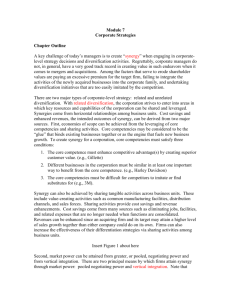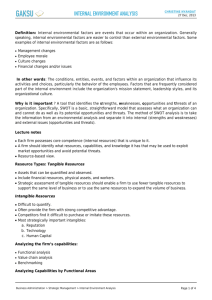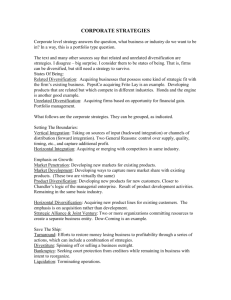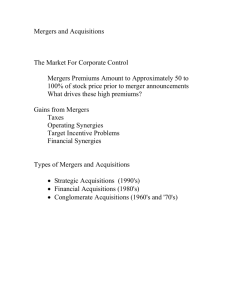Chapters 1 and 2
advertisement
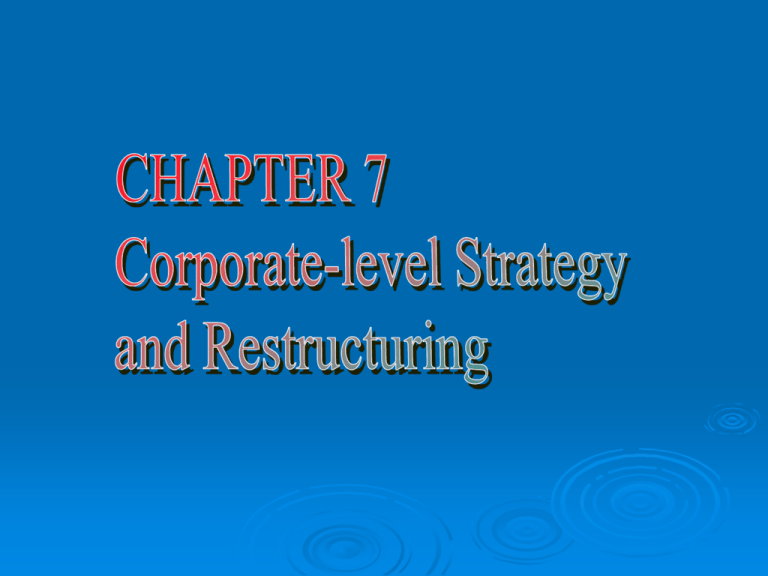
Learning Objectives Understand the basic corporate-level strategies and their strengths and weaknesses Identify the factors that are necessary for a diversification strategy to produce synergy Analyze existing and suggest potential corporate-level competencies for a firm Suggest methods to avoid pitfalls and enhance the probability of success in mergers and acquisitions Understand the basic types of restructuring and how restructuring can be successfully executed Create a portfolio matrix for a corporation and understand what it means Corporate-level Strategy Formulation Responsibilities Direction Setting Development of Corporate-level Strategy Establishment and communication of organizational mission, vision, enterprise strategy and long-term goal Broad approach to corporate-level strategy—concentration, vertical integration, diversification, international expansion Selection of resources and capabilities in which to develop corporate-level distinctive competencies Selection of Businesses and Portfolio Management Buy and sell businesses Allocation of resources to business units for capital equipment, R&D, etc. Corporate-level Strategy Formulation Responsibilities Selection of Tactics for Diversification and Growth Choice among methods of diversification—internal venturing, acquisitions, joint ventures Management of Resources Acquisition of resources and/or development of competencies leading to a sustainable competitive advantage for the entire corporation Hire, fire and reward business-unit managers Ensure that the business units (divisions) within the corporation are well managed, including strategic management. Provide training where appropriate Develop a high-performance corporate management structure Develop control systems to ensure that strategies remain relevant and that the corporation continues to progress towards its goals Corporate-level Strategies Concentration Internal Growth Concentration Mergers and Acquisitions Vertical Integration Related Diversification Joint Ventures Unrelated Diversification Advantages and Disadvantages of Concentration Advantages Allows an organization to master one business Less strain on resources, allowing more of an opportunity to develop a sustainable competitive advantage Lack of ambiguity concerning strategic direction Often found to be a profitable strategy, depending on the industry Disadvantages Dependence on one area is problematic if the industry is unstable Primary product may become obsolete Difficult to grow when the industry matures Significant changes in the industry can be very hard to deal with Cash flow can be a serious problem Advantages and Disadvantages of Vertical Integration Internal Benefits Integration economies can eliminate steps, reduce duplication and cut costs Improved coordination reduces inventorying and other costs Avoids time-consuming tasks, such as price shopping, communicating design details and negotiating contracts Internal Costs Need for overhead to coordinate vertical integration Burden of excess capacity if not all output is used Poorly organized firms do not enjoy enough synergy to compensate for the higher costs Advantages and Disadvantages of Vertical Integration Competitive Benefits Avoid getting shut out of the market for rare inputs Improve marketing or technological intelligence Can create differentiation through coordinated effort Superior control of firm’s market environment Increased ability to create credibility for new products Synergies could be created by coordinating vertical activities carefully Competitive Dangers Obsolete processes may be perpetuated Reduces strategic flexibility due to being “locked in” to a business May link to unprofitable adjacent businesses Lose access to information from suppliers or customers May not be potential for synergy because vertically integrated businesses are so different May use the wrong method of vertical integration (i.e., full integration instead of contracting) Transactions Costs Transactions costs economics Study of economic transactions and their costs Transactions costs are reflected by the time and resources devoted to contract creation and enforcement Make or Buy Decisions Firms should usually buy what they need in the market as long as they do not have to expend an undue amount of time or other resources in contract creation and enforcement A market failure means that these costs are high and it is in the best interests of the firm to vertically integrate instead of buying from the market Transactions Costs Transactions costs tend to be high when: The future is highly uncertain There are only one or a small number of suppliers One party to the transaction has superior information Asset specificity--asset investment that can be used for only one purpose Transaction costs are high (market failure) when: Highly uncertain future One or small number of suppliers Knowledge differences Asset specificity Substitutes for Full Vertical Integration Taper Produce some in-house and buy the rest Quasi Integration Integration Purchase most of what you need from a supplier in which the purchaser holds an ownership stake (i.e., stock) Long-term Contracts Helps achieve some of the benefits of vertical integration, such as more assurance of supply or more control over quality Reasons for Diversification Strategic Reasons • Risk reduction through investments in dissimilar businesses or less dynamic environments • Stabilization or improvement in earnings • Improvement in growth • Use of excess cash from slower-growing traditional areas (a form of organizational slack) • Application of resources, capabilities or core competencies to related areas • Generation of synergy through economies of scope • Use of excess debt capacity (also a form of organizational slack) • Ability to learn new technologies • Increase in market power Reasons for Diversification Motives of the CEO Desire to increase the value of the firm Desire to increase personal power and status Desire to increase personal rewards such as salary and bonuses Craving for a more interesting and challenging management environment Requirements for the Creation of Synergy Relatedness Tangible--same physical resources for multiple purposes Intangible--capabilities developed in one area can be used elsewhere Managerial actions to share resources or skills Benefits must exceed costs of integration Requirements for the Creation of Synergy Fit Strategic--matching of organizational capabilities--complementary resources and skills (based on relatedness, as described above) Organizational--similar processes, cultures, systems and structures • Dominant logic--the way managers deal with managerial tasks, the things they value, and their general management approach Potential Sources of Synergy from Related Diversification Operations Synergies Common parts designs: Larger purchased quantities allows lower cost per unit Common processes and equipment: Combined equipment purchases and engineering support allow lower costs Common new facilities: Larger facilities may allow economies of scale Potential Sources of Synergy from Related Diversification Operations Synergies (Continues) Shared facilities and capacity: Improved capacity utilization allows lower per unit overhead costs Combined purchasing activities: Increased influence leading to lower costs, and lower cost shipping arrangements Shared computer systems: Lower per unit overhead costs and can spread the risk of investing in higher priced systems Combined training programs: Lower training costs per employee Potential Sources of Synergy from Related Diversification R&D / Technology Shared R&D programs: Spread overhead cost and risk of R&D to more than one business Technology transfer: Faster, lower cost adoption of technology at the second business Development of new core businesses: Access to capabilities and innovation not available in the market Multiple use of creative researchers: Opportunities for innovation across business via individual experience and business analogy Potential Sources of Synergy from Related Diversification Marketing Shared brand names: Build market influence faster and at lower cost through a common name Shared advertising and promotion: Lower unit costs and tie-in purchases Shared distribution channels: Bargaining power to improve access and lower costs Cross-selling and bundling: Lower costs and more integrated view of the marketplace Potential Sources of Synergy from Related Diversification Management Similar industry experience: Faster response to industry trends Transferable core skills: Experience with previously tested, innovative strategies and skills in strategy and program development Forces that Undermine Synergies Management Ineffectiveness Too little effort to coordinate between businesses means synergies will not be created Too much effort to coordinate between businesses can stifle creativity Administrative Costs Additional layers of management and staff add costs Executives in larger organizations are often paid higher salaries Delays from and expense of meetings and planning sessions necessary for coordination Extra travel and communications costs to achieve coordination Forces that Undermine Synergies Poor Strategic Fit Relatedness without strategic fit decreases the opportunity for synergy Overstated (or imaginary) opportunities for synergies Industry evolution that undermines strategic fit Overvaluing potential synergies often results in paying too much for a target firm or in promising too much improvement to stakeholders Poor Organizational Fit Incompatible cultures and management styles Incompatible strategies, priorities, and reward systems Incompatible production processes and technologies Incompatible computer and budgeting systems Unrelated Diversification Conglomerates Large, unrelated diversified firms Popularity of Unrelated Diversification in the 50s, 60s and early 70s Rigid antitrust enforcement Financial theories supported the idea that risk could be reduced by investing in businesses in unrelated businesses with uneven revenue streams Unrelated Diversification Most Research Suggests that Unrelated Diversification is Not High Performing Places unusual demands on managers Trend is towards reducing diversification (refocusing) In spite of the negative evidence, some firms have been successful with this strategy Mergers and Acquisitions M&A Basics Mergers occur any time two organizations combine into one Acquisitions occur when one firm buys another firm Most mergers are in the form of an acquisition, so these terms are often used as synonyms M&As tend to depress profitability, reduce innovation and increase leverage, at least in the short run Industry Consolidation Occurs as competitors merge together A dominant trend in the U.S. and elsewhere Mergers and Acquisitions Corporate Raiders Engage in acquisitions, typically against the will of target companies (called hostile) Hostile acquisitions tend to be more expensive May motivate target firm managers to be more responsive to stockholder interests (reduce agency costs) Problems with Mergers and Acquisitions High Costs High Premiums Typically Paid By Acquiring Firms Increased Interest Costs from Higher Leverage High Advisory Fees and Other Transaction Costs Poison Pills—things target companies do so they are less attractive to takeover Problems with Mergers and Acquisitions Strategic Problems High Turnover Among the Managers of the Acquired Firm Short-Term Managerial Distraction—takes managers away from the critical tasks of the core businesses Long-Term Managerial Distraction—lose sight of the factors that lead to success in their core businesses Less Innovation No Organizational Fit—cultures or systems don’t combine well Increased Risk—increased leverage. Also the risk of unsuccessful management Successful Mergers and Acquisitions Low debt Friendly negotiations Complementary resources (relatedness) Cultures and management styles are similar (organizational fit) Post-merger sharing of resources Due diligence before merger Learning occurs Corporate-level Distinctive Competencies Come from achieving shared advantage across the businesses of a multi-business firm Integrated managerial skills • Attracting and retaining competent top managers Shared use of resources that are hard to acquire except through experience • A well-developed strategic planning system Shared use of resources that contribute significantly to perceived customer benefits • Excellent R&D Resources that can be widely applied across businesses • Excellence in tax management Strategic Restructuring Retrenchment (Downsizing) Turnaround through workforce reductions, plant closings, outsourcing, cost controls, etc. Downsizing is dangerous to the health of an organization Refocusing (Downscoping) Reducing diversification through selling off nonessential businesses • Divestiture--reverse acquisition • Spin-off--current shareholders are issued stock Chapter 11 Reorganization Legal filing allowing protection from creditors and others while problems are worked out Should probably be a strategy of last resort Strategic Restructuring Leveraged Buyouts Private purchase of a business unit by managers, employees, unions or private investors High levels of debt Asset sales typically lead to a smaller, more focused firm Stifle innovation Changes to Organizational Design Switch to a new organizational structure • More decentralized or more centralized, depending on needs • Linked also to changes in the culture of a firm Reengineering involves radical redesign of core business processes to achieve dramatic improvements in efficiency and quality Boston Consulting Group (BCG) Matrix High Star Business Growth Rate Cash Cow Dog Low High Low Relative Competitive Position (Relative Market Share) Major Concepts in Chapter 7 Corporate-level strategy focuses on the selection of businesses in which the firm will compete, and on the tactics used to enter and manage those businesses Primary corporate-level responsibilities include establishing direction for the whole organization, formulation of a corporate strategy, selection of businesses, selection of growth tactics, and resource management Concentration is associated with a focus on one business area, which allows the company to specialize; however, the firm is dependent on one business for its growth and profitability Major Concepts in Chapter 7 Vertical integration allows a firm to become its own supplier or customer, which can provide more control over processes and quality. However, the firm is still dependent on one business According to the theory of transaction costs economics, firms should generally purchase what they need from the market, unless transactions costs are high. Unrelated diversification was popular in the past due to financial theories and rigid antitrust enforcement; however, unrelated firms are hard to manage and there is a recent trend towards refocusing Major Concepts in Chapter 7 Mergers and acquisitions are the quickest way to diversify; however, they are fraught with difficulties, and most of them fail to meet expectations Restructuring approaches include retrenchment (downsizing), refocusing (downscoping), Chapter 11 reorganization, leveraged buyouts (LBOs) and changes to organizational design
